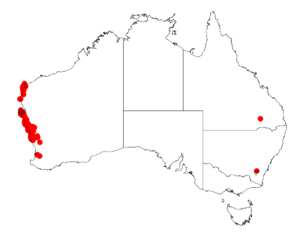Gold carpet facts for kids
Quick facts for kids Gold carpet |
|
|---|---|
| Scientific classification | |
| Genus: |
Acacia
|
| Species: |
spathulifolia
|
 |
|
| Occurrence data from AVH | |
Acacia spathulifolia is a type of shrub often called Gold carpet or Gold carpet wattle. It belongs to the Acacia plant family. This plant grows naturally only in coastal areas of western Australia.
Contents
What is Gold Carpet Wattle?
This plant is a thick, spreading shrub. It usually grows between 0.5 to 3.0 metres (1.6 to 9.8 ft) tall. Its branches are smooth or have very fine hairs. Like most Acacia plants, it has special leaf-like parts called phyllodes instead of true leaves.
These phyllodes are thick and fleshy. They are flat and shaped like a narrow spoon. Each one is about 1 to 2 cm (0.39 to 0.79 in) long and 1.5 to 4.5 mm (0.059 to 0.177 in) wide. They are smooth and can be green to yellow-green. They also have clear yellow lines along their edges.
Flowers and Seed Pods
The Gold carpet wattle blooms a lot from June to October. It produces bright yellow flowers. These flowers grow in round clusters called inflorescences. Each flower-head is about 5 to 6 mm (0.20 to 0.24 in) across. They are packed with 9 to 15 golden flowers.
After the flowers, the plant grows brown seed pods. These pods are thin and shaped like a narrow rectangle. They can be up to 4 cm (1.6 in) long and 4 to 4.5 mm (0.16 to 0.18 in) wide. The pods are smooth and have thin lines on them. Inside, the seeds are shiny and dark brown. They are up to 4 mm (0.16 in) long and have a white part called an aril.
How it was Named
A botanist named Bruce Maslin first officially described this plant in 1978. He wrote about it in a science journal called Nuytsia. Later, in 2003, another botanist, Leslie Pedley, gave it a different name, Racosperma spathulifolium. But in 2006, it was moved back to the Acacia group.
Where it Grows
The Gold carpet wattle is found in the Mid West, Wheatbelt, and Gascoyne regions of Western Australia. It likes to grow in sandy soils. You can often find it on sandplains and near coastal limestone areas.
Its natural home stretches from Cape Range National Park in the north. It goes south along the coast through places like Kalbarri and Jurien, where it is very common. It can also be found further inland, as far as Mullewa and Piawaning. This plant is usually part of coastal heath, low woodlands, and shrubland areas.
Growing Gold Carpet Wattle
Because of its unique spoon-shaped leaves and bright golden flowers, this plant is great for gardens. It makes a beautiful groundcover.

